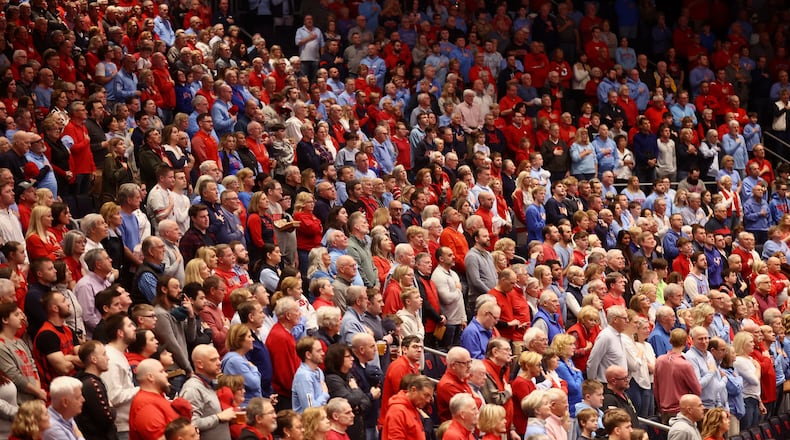In the email, Sullivan wrote, "In our first seating program adjustment in seven years, the 2025-26 seating donation structure will appear on your May invoices. For most seats in the lower arena, the 2025-26 modification will be less than the 2017 change tied to our arena project and fall approximately in the 7-12% range in the first two years, with an escalator in year 3. Seats in the 300 level will increase $25 each, and starting this season, seats in the 400 level, where an Arena Seating Program contribution was not previously required, will now be part of the program at $25 per seat or just over a dollar per game.
“The incremental funds are targeted solely on this new basketball environment. This is not funding administrative costs or non-basketball operations. These revenues are being reinvested directly into the core of the players’ share.”
How much will those players make? Sullivan didn’t name an exact figure but wrote, “I acknowledge the natural questions around what our total team compensation might look like and how that will align with our competitive goals. At this stage, it’s still too early to determine an exact figure, but we are under no illusions about the scale of investment required, which is well into the millions.”
Sullivan’s email comes as UD prepares to enter a new era in which it will pay athletes directly. A $2.78 billion lawsuit settlement (House vs. NCAA) is expected to be approved soon even though a judge delayed the settlement last week over a concern about roster limits.
“Regardless of the final details of the settlement,” Sullivan wrote, “the shift toward direct compensation from institutions to student-athletes is no longer a matter of speculation. It has arrived. This brings radical transformation to the economic model of college sports, a model that is reshaping the game.
“Under the terms of the settlement, the total value of new payments and benefits from colleges to athletes is expected to exceed $20 billion over the next 10 years. It is estimated that Division I college athletes will now be eligible to receive benefits collectively approximating 51% of future athletic revenues—comparable to professional sports.
“The settlement allows institutions to make payments to student-athletes up to a capped amount (currently about $21 million per school, per year across sports). The cap will be re-evaluated every few years and has a 4% automatic annual escalator. The cap is based on a formula of the average Power 5 school’s revenue, so major college football revenue accounts for a majority of that cap. The settlement aims to limit fraudulent payments from boosters and fans that circumvent the cap, but skepticism around interpretation and enforcement of that principle remains.
“With or without the settlement, direct revenue sharing is here. We will continue our strong partnership with Dayton 6th as a marketing agency but UD will hold the primary contractual relationship with the players. Dayton 6th may engage in NIL agreements with student-athletes but only for a valid business purpose to promote goods and services provided to the general public with payments at fair market value rates.”
Credit: David Jablonski
Credit: David Jablonski
The rise in prices comes later than expected. The original plan when the UD Arena renovation project was announced in 2017 called for no price increases for a five-year period from the 2019-20 season through the 2023-24 season.
UD delayed the price increase because of the “uncertain legal and regulatory matters around student athlete compensation and benefits,” Sullivan wrote in a 2024 email. “Serious questions of labor law and numerous antitrust lawsuits could fundamentally alter the relationship between institutions and student-athletes in the near future. One possible outcome is institutions compensating students directly for their athletic services and for use of their name, image and likeness, as opposed to only third parties. If that occurs, we will have to navigate the market conditions together.”
The Dayton men’s basketball team has sold out four straight seasons. Its sellout streak stands at 77 games.
Dayton ranked 20th in average attendance in the 2023-24 season after ranking 21st in the 2022-23 season and 19th in the 2021-22 season. It averaged 13,407 fans each season and had the same average this past season.
Sullivan ended the email by telling fans they are the heartbeat of the program and UD doesn’t take them for granted.
“This season didn’t end the way we expected, but we press ahead with the reality of where the sport is headed,” Sullivan wrote. “We know the current structure in college sports is not ideal. We hope the settlement is a step in the right direction. We also know the transfer portal and the nature of transactional player movement can be frustrating. We wish it looked different. But it doesn’t.
“We are choosing to face this moment head-on and find opportunity in the disruption. We have the strength of our history, strength of our fans and our community. We’ve done it before, and we’ll do it again.
Now, more than ever, we ask you to stay on this journey with us into the new era of college sports."
In January, Sullivan talked about the coming price increase.
“We have a great relationship with our fans,” he said. “We’re very lucky. We’re very fortunate to have them. Every time we have to rise to the occasion as new things develop in college sports, they’ve gone with us, but I wasn’t comfortable just dribbling out, ‘We’re going to do this, but then we’re going to do that.’ I want to have a comprehensive strategy that fans can digest and understand. (The increase) will be very transparent and very honest and very much directed toward the players.
“I don’t need ticket price increases paying for administrative bloat or those types of things. I really have been delaying that until I had a clear picture. I think we do have a clearer picture now. I view our fans as investors in our program, and they’re owed to know if we’re asking them to step up, how much it’s going to be, how it’s going to be spent and what we plan to invest it in.”
About the Author


